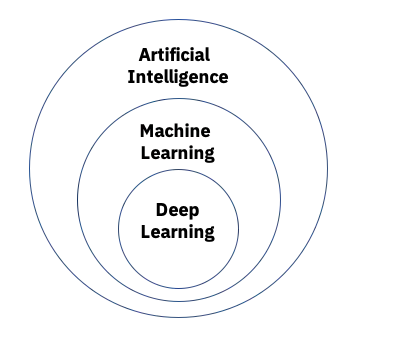Artificial Intelligence (AI) isn't just a buzzword!
We hear the term "AI" used everywhere, in news, social media, and at conferences, but not many people know what this concept really means. It is often used to refer to other complex algorithms that do not qualify as AI at all.
So how should we define it?
What is Artificial Intelligence?
Sometimes AI is used interchangeably with other terms like "Machine Learning" and "Deep Learning", but they're not the same. In fact, ML is considered a subset of AI, and DL is actually a sub-field of Machine Learning.
Machine Learning is one of the most common types of Artificial Intelligence. Machine learning is primarily used to process large amounts of data quickly.
IBM says "Artificial Intelligence (AI) leverages computers and machines to mimic the problem-solving and decision-making capabilities of the human mind".
This graphic by IBM clearly shows the relationship between concepts:

An what is Artificial Intelligence in the context of eLearning? According to eLearning Industry "An AI-based eLearning platform is a machine/system that possesses the ability to perform different tasks requiring human intelligence. It has the ability to offer solutions to human-related problems, like speech recognition, translations, decision making, and much more."
Why Use AI in eLearning
The traditional corporate training model presents some common challenges, including:
- Too much content and way too long: Most traditional learning programs still are made of long-form modules. And creating an hour of such training content requires way too many hours. This overwhelms people very easily!
- Lack of personalized experiences: Because content creation is time-consuming, eLearning courses are often too generic and do not adapt to the specific needs of each employee.
- Don't really track the program's effectiveness: Calculating the ROI of traditional training involves time-consuming data collection and entry processes.
- It doesn't match the digital workforce existing needs and expectations: training is no longer an initiative that happens once or twice a year but is an ongoing process. Today's workforce (including mostly millennials and Gen Z) prefer to self-manage their learning experiences, according to a LinkedIn Learning report.
Applying Artificial Intelligence to corporate training and eLearning courses specifically solves many of these challenges.
How Artificial Intelligence Is Transforming the eLearning Industry
Companies are increasingly recognizing the potential of using AI in learning and development. In fact, according to the 2019 Gartner CIO Survey, 37% of companies had implemented some type of AI, representing a huge 270% increase over the past four years. In addition, the same report estimates that by 2021, 80% of emerging technologies will be based on AI.
Here are four ways Artificial Intelligence is transforming the eLearning industry:
1) Personalized learning paths: Provide the right content to the right person at the right time:
Personalization is no longer just considered a desire of the modern workforce; it's an expectation. Your workers want content that includes some kind of personalized experienced - where they are the protagonist.
Read more: Learner-Centered Design: The Secret of Creating Engaging eLearning Experiences
eLearning platforms that leverage Artificial Intelligence can customize content based on each student's existing knowledge and needs rather than providing a one-size-fits-all approach.
Personalized or adaptive learning is a data-driven approach, which continuously tracks each student's performance, using machine learning algorithms to predict results and adapt content to reflect each student’s expertise and preferences. Therefore, if a student is trying to master a new skill, the platform will continue to adapt the material and difficulty levels based on their progress, until they have officially mastered the concept. Preparing a personalized learning path for each student with relevant topics not only improves time efficiency but also increases students' motivation levels.
For instance, to learn about a topic, the employee needs several perspectives on what he or she is studying, especially on complex topics.
In mechanical engineering, to design an internal combustion engine, a student needs to understand how the engine works, its parts, and how they interact with each other. To have a deep understanding, they need to see several models and analyze how in each case it works differently, but follows the same principles, and fulfills the same function.
This process is not linear and is not the same for each student. One student may find it faster to see a video and start implementing it in real life, while another may find it easier to see a visual blueprint, and another may understand it by reading a detailed description of how it works.
In the study of other subjects, it works the same: it is not enough with a single method to fully master a concept, and the different methods that are used, the way they are used, and the degree to which the student needs to rely on each one, change from one person to another.
With the traditional training approach, there is a single learning path, and the instructor/course creator defines the same order of content for all students equally; content is generic and content is not adapted in relation to the interests of each person.
If incorporating eLearning platforms is a first step towards creating more effective corporate development systems, AI onboarding is the second: through data analysis of employee activity on learning platforms, content is adapted and personalized learning paths and content recommendations are made to each student, based on their role, preferences, and prior behavior.
The result is a dynamic, flexible, personalized, and effective training approach, which adapts as a living organism to the needs of each employee and assists him or her in the process of being the director of their own learning.
Also read: The Rapid Rise of Learning Pathways
2) Better Decision Making: Advanced Analytics
When it comes to evaluating your employees' performance, instructors and/or training leaders face common limitations: they take a long time, and the information isn't really detailed enough.
However, by leveraging an Artificial Intelligence-based eLearning platform, it becomes possible to quickly analyze huge amounts of data, as well as identify patterns and trends to continuously optimize and improve learning experiences.
Specifically, content analytics refers to eLearning platforms that leverage AI (specifically machine learning) to optimize learning modules. This way, corporate leaders are able to not only create and manage their eLearning content but also obtain important information about student progress and understanding through powerful data analytics.
Artificial Intelligence enables Instructors and L&D leaders to receive detailed information about each student's performance, strengths, struggling areas, and even attendance issues. This makes it easier to make decisions and the ability to optimize and take action before the employee is not motivated to continue and leaves the course.
Also read: Why Aren’t Employees Completing Your eLearning Courses?
3) Create eLearning Courses In Less Time
Traditionally, for subject matter experts and instructional design professionals, creating courses is one of the most time-consuming tasks. Fortunately, leveraging Artificial Intelligence in eLearning helps make the course creation process much simpler, faster, and more agile without having to sacrifice quality.
Automatic translation and localization feature is a great example of how Artificial Intelligence is enhancing the eLearning development process - offering more speed and efficiency.
When using common development methods, translating eLearning content is not an easy task. Considering the large amount of content that needs to be created, making this same content accessible for multiple languages becomes even more time-consuming and expensive!
But with AI, it is now possible to develop multi-language content for global companies facing the challenge of creating useful content for branches in multiple countries, or for the increasingly common situation of companies working with remote teams that speak different languages.
Using an authoring tool like SHIFT, companies can reduce the time involved in localization services of an eLearning program from months to just days; boosting the development process for projects that require content available in multiple languages.
4) Expanded Engagement: Chatbots and Virtual Tutors to Support Learners
Through Artificial Intelligence, assessments can be performed easily and process inquiries from employees/students in real-time, to accelerate and personalize the learning process.
An example might be a chatbot that "decides" what question to ask a student based on the student's previous answers, such as adding questions in areas where the student has had the most incorrect answers or jumping to a higher level when the student consistently enters the correct answers. Another common use is to answer simple questions: the AI algorithm may receive basic information that, for example, a new contributor may need. It can be presented as a smart chatbot that analyzes and responds to conversational text messages and questions from those employees.
Like chatbots, virtual assistants can help both students and instructors by answering questions that might otherwise have been sent directly to the instructor, or by helping students navigate course material in a friendlier way.
In addition, eLearning platforms that use chatbots become a "guide" for students to support them every step of the way - for instance helping them discover relevant resources based on their profile and topics of interest by suggesting various learning assets, eliminating the time and effort that it would take to perform this task manually.
Also read: The new role of the instructional designer
The Future of eLearning
Over the past 4 years, the use of this technology in the training and development industry increased by 47.5%, and investment in artificial intelligence is expected to reach $190.61 billion by 2025.
Recommended read: AI in Education Will Grow Exponentially by 2021
In the future, we can expect that many processes that today fall on people will be in charge of artificial intelligence, but it is not to be alarmed: this only means that people will be better trained and that they will be able to take on more complex tasks.
By harnessing the power of Artificial Intelligence, companies can offer personalized learning at scale to save both instructors and employees time, allowing them to focus on more critical tasks. And thanks to the benefits we discussed earlier, such as adaptive learning, advanced analytics, and time optimization in the creation process, employees will be more engaged and more interested in learning, resulting in better results and increased productivity.
Also read: The Role of Artificial Intelligence in E-learning


